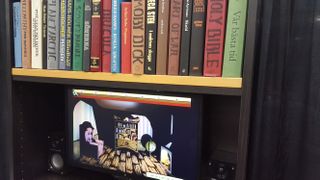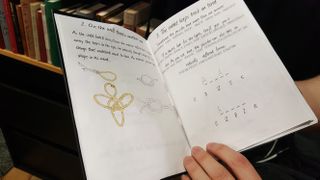Puzzle game Cryptogram uses a real bookshelf to open secret doors
Find the right book, solve the riddle.

I've never in my life had the experience of tilting a book off an old dusty bookshelf and unlocking a secret passageway, but I hope I do before I die. Movies have never sold us a more believable-but-still-magical fantasy than the passage behind the bookshelf, or the revolving bookshelf that turns under your feet and rotates you, speechless, into a hidden laboratory. But I have now gotten to play a game inspired by that fantasy, and it's one of the most creative things I've seen at this year's Game Developer's Conference.
GDC hosts a small selection of games with weird input methods every year under the banner of Alt.Ctrl.GDC, and the standout for me this year was bookshelf game Cryptogram. The setup is what caught my attention first. Two rows of books line a bookshelf, with a monitor in the center showing a simple room in a creepy manor. A journal of 30 or so pages contains clues that correspond to each room in the manor, and offer a hint on how to get out. But to find the right hint, you first have to figure out which chapter of the journal corresponds to the room you're in.
"A second me" refers to a room with a ghostly figure in a mirror. "The first sin" refers to a room with a hissing snake in the corner. From there, each journal entry is a puzzle that culminates in that action I've always wanted: tilting a book forward on the shelf, feeling it go taut as it triggers a mechanism inside the bookshelf, and hearing a metallic clang that indicates success. On the screen, the bookshelf slides to the side, and the screen fades as we enter the secret passage to the room beyond. It's almost the fantasy brought to life.
Cryptogram was designed by a group of Swedish students in just eight weeks. Eight weeks! Producer Daniel Qvarnemark told me that the trapdoors I dream of were indeed the inspiration. "We came up with the controller before we came up with the game," he said. "We weren't really sure how it would work when we first came up with the concept of playing a game with a bookshelf. Everything came from that. The fact that it's a puzzle game. It's a more logical thing to do with this kind of controller."

Qvarnemark gave me a short explanation of how they built the bookshelf input for Cryptogram, which is programmed in Unity.
"Behind the books are cords," he said. "When you pull them they tense and push a button. Each input is more or less a keyboard input. We have an I-PAC card behind there. It's pretty simple. Each book when you pull it in a writing program, the input shows letters."
Cryptogram's rooms will appear in a random order, but once you've seen all the puzzles there's not much to replay. But in the place of a true trapdoor bookshelf, it's something I'd love to run into in a dusty corner of a creaky mansion and play for half an hour. And then show to my group of friends before we run away from a miner dressed like a ghost, or something.
The biggest gaming news, reviews and hardware deals
Keep up to date with the most important stories and the best deals, as picked by the PC Gamer team.

Wes has been covering games and hardware for more than 10 years, first at tech sites like The Wirecutter and Tested before joining the PC Gamer team in 2014. Wes plays a little bit of everything, but he'll always jump at the chance to cover emulation and Japanese games.
When he's not obsessively optimizing and re-optimizing a tangle of conveyor belts in Satisfactory (it's really becoming a problem), he's probably playing a 20-year-old Final Fantasy or some opaque ASCII roguelike. With a focus on writing and editing features, he seeks out personal stories and in-depth histories from the corners of PC gaming and its niche communities. 50% pizza by volume (deep dish, to be specific).
Most Popular


